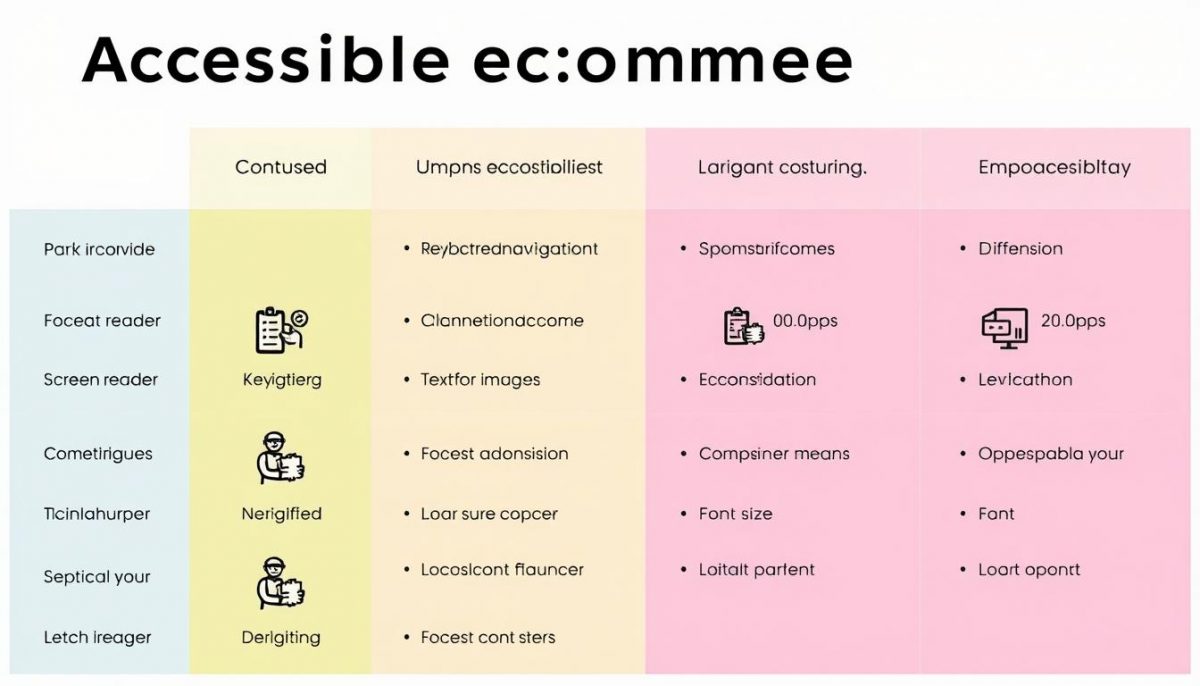In our digital world, making ecommerce accessible is crucial. As online shopping grows, ensuring everyone can participate becomes key. This includes people with visual, hearing, and cognitive challenges. It’s important for online stores to be welcoming for all shoppers.
Ecommerce sites that focus on accessibility can improve their site’s ease of use. This can attract more customers and build their loyalty. Also, being inclusive shows a business cares about all its customers. It shows a commitment to helping everyone.
Understanding the Importance of Accessibility in Ecommerce
Creating an accessible ecommerce site is vital for reaching more customers. Accessibility greatly improves user experience and can boost sales. By focusing on inclusive design, online stores can serve everyone, including those with disabilities. This approach enhances shopping for all customers. Roughly 15% of people worldwide have a disability, making accessibility a key focus for ecommerce sites.
Why Accessibility Matters for Online Retailers
Adding accessibility features has many benefits for businesses:
- Wider market reach, as inclusive design can draw in consumers from diverse backgrounds.
- Improved customer loyalty, with users feeling valued and respected.
- Enhanced reputation, allowing brands to demonstrate social responsibility.
Legal Obligations and Compliance Standards
Retailers have legal duties regarding ecommerce accessibility. ADA rules for online shops are a must-follow. Ignoring these rules poses legal risks, including lawsuits and damaged reputations. The Web Content Accessibility Guidelines (WCAG) offer directives for making digital spaces accessible.
| Compliance Aspect | Description | Legal Implications |
|---|---|---|
| ADA Compliance | Ensures websites are accessible to individuals with disabilities. | Potential lawsuits and financial penalties for non-compliance. |
| WCAG Standards | Provides guidelines for creating accessible web content. | Failure to meet these can result in reputational harm. |
| Inclusive Design | Aims to enhance usability for all users, not just those with disabilities. | Can improve market reach and customer satisfaction. |

Accessibility in Ecommerce: Building Inclusive Shopping Experiences
Making an accessible ecommerce platform means adding features for everyone’s needs. By focusing on key elements, companies can offer easy shopping experiences. This enables everyone to fully use their online store.
Key Features for Accessible Online Stores
Adding accessible features to your ecommerce site is crucial. It helps your website reach a wider audience. Consider these important elements:
- Alt text for images to describe visuals for screen reader users.
- Keyboard navigation support that allows users to navigate the site without a mouse.
- Adjustable text sizes to enhance readability for individuals with visual impairments.
- High color contrast between text and background to improve visibility.
- Logical layout that follows a clear structure to aid in navigation.
Optimizing Your Website for All Users
Optimizing your ecommerce site for accessibility means making it work with assistive technologies. It’s important to regularly check your site to find and fix barriers. Here’s how to make your site better for everyone:
- Implement ARIA (Accessible Rich Internet Applications) landmarks to improve navigation for screen reader users.
- Test the website with various assistive technologies, such as screen readers and voice recognition software.
- Solicit feedback from users with disabilities to gain insights into potential improvements.
- Train your team on inclusive web design principles to foster a culture of accessibility within your organization.

| Feature | Description | Benefits |
|---|---|---|
| Alt Text | Text description for images | Helps visually impaired users understand image content |
| Keyboard Navigation | Navigation via keyboard shortcuts | Enhances accessibility for users who cannot use a mouse |
| Adjustable Text Sizes | Options to change font size | Improves readability for all users |
| Color Contrast | Strong contrast between text and background | Aids users with low vision |
| Logical Layout | Structured arrangement of website elements | Facilitates easier navigation and understanding |
Best Practices for Enhancing Accessibility in Your Ecommerce Platform
Making your online store more accessible is key to reaching more people. It leads to happier shopping for everyone. Retailers should train their staff regularly on how to make things more accessible. This training increases awareness and helps the team handle accessibility questions better. They learn about different customer needs. Working with experts in accessibility gives insights on making a shop more welcoming for all.
Asking for feedback from people with disabilities is also important. Their opinions can point out problems and improve how an online shop is set up for everyone. Also, having a clear plan for making things accessible is crucial. It should be part of how the shop is designed. This shows that the business truly cares about welcoming everyone.
Last, following WCAG guidelines and picking CMS that are easy to use for everyone are key steps. Adding tools that improve accessibility helps too. It ensures that making your shop better for everyone is an ongoing effort. Showing that you are always working on being more inclusive wins trust from customers. It shows that you’re keeping up with what modern ecommerce needs.

